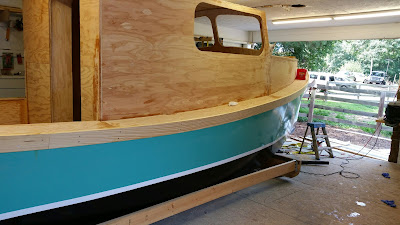 |
| You will notice portholes are in. The fence to the right is gone now and in its place a 16' gate. |
I lead off this post with a picture of Miss Addy pulled out of the shop so we can finally get some idea of what she looks like. I think we are all pretty much in agreement that she has taken shape as hoped.
 |
| Bo likes it (or is he just hungry?) |
The first step was getting it out of the shop. We at first tried a Warn Power Puller winch, no good. It bogged then shut down repeatedly. We then resorted to the tractor which did great and had wished we just tried it before. We bolted in a couple of heavy duty D's and used large yellow straps to pull it. Once out it was time to start framing the ceiling.
 |
| First layer going in... |
What was decided is a frame grid of 1" x 2" pine (and wider in places to support handrail) and an infill with two 3/4" layers of polystyrene foam sheet. Instead of epoxy this time and because we were basically putting in a frame on 2' centers, we used a generous amount of PL Premium adhesive and screws. All layers screwed and glued together. The first layer was attached and allowed to setup overnight so that I could route and hole saw recesses without gumming up the bits with soft glue.
 |
| Recessed holes for 2W LED pocket lights and access holes for future equipment (to be covered with small plates). |
Now that this was accomplished we used a router with a 3/4" mortising bit and played "connect-the-dots". This was to receive 3/4" PEX tubing which has a larger OD than the foams thickness so we had to route the bottom of the second layer of foam as well as the next layer of 3/4"x2" pine battens.
Now for the pipe. It was simply mashed into place and took a little squeeze from a pair of pliers to get it into the wood on the batten crossings.
This left us with the 1/4" covering skin of Marine AB fir. Clamped, marked and glued in place it was pretty straightforward.
Screwed and glued into place, it was time for the Xynole fabric and epoxy. Wet out was much easier than the hull as temps were in the upper 90's. Just worked quick, poured and slowly dragged it around with squeegees. This was after the normal screw hole and seam fill using an epoxy and microballoon fairing mix.
All surfaces were flush planed and sanded and the edge rounded over slightly so that the fabric would roll over without creating a wear point.
The roof was primed and painted without a full weave-fill like the sides will see. We wanted that "painted canvas" look. the last coat was rolled on. Spraying just wasn't building it fast enough. One note and this can be seen if you zoom into the roof at the AC opening is where we had to deal with a fabric edge seam. I fought this on the hull and knew that the best tack here would be to treat it as something that cannot be convincingly hid by careful matching. What was done instead was to lay two pieces of Frogtape about and inch apart, centered on the seam. Then, using a filler mix, we squeegeed' an overlapping fill from the AC opening to the edge and down to the end of the fabric. Immediately pulling the tape off each side left a thin, clean line that would make you think it was somehow seamed professionally.
That was it. the roof is complete and using a few nailed-together 2"x6"x16's as a pusher, we shoved the boat back in her house for now as we move on to glassing and painting the outside final.





























